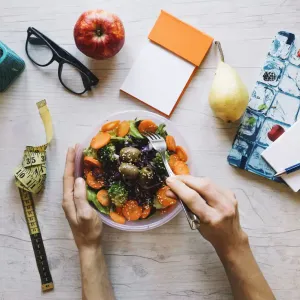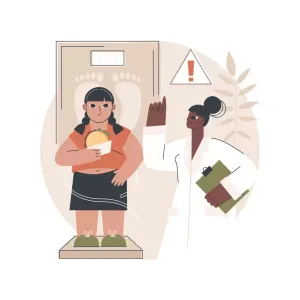

Our Review Process
Our articles undergo extensive medical review by board-certified practitioners to confirm that all factual inferences with respect to medical conditions, symptoms, treatments, and protocols are legitimate, canonical, and adhere to current guidelines and the latest discoveries. Read more.
Our Editorial Team
Shifa Fatima, MSc.
Author
Dr. Apoorva T, MHM.
MEDICAL ADVISOR
Worst Food For People With Diabetes
If you have diabetes, you know and understand how difficult it can get to keep the blood sugar levels under control. The constant check on your diet, the cumbersome nature to carry your glucometer around everywhere you go, having to keep sugar pills with you in case of a drop in the levels, and so many more aspects that are attached to this disease can get tedious to deal with. This is why doctors say that the best way to ensure that the blood glucose levels remain in check is by maintaining a proper diet. If you have been diagnosed already, your doctor must have recommended you to a dietician, who, in turn, must have provided you with a list of what not to eat with diabetes. Reading that list may get a little dejecting because everything that you would be asked to avoid must fall under the so-called tasty food item list and you should be aware of what are the best cereals for diabetics and what food is bad for diabetes to avoid to keep blood sugar level in control.
Do not worry if you do not have this list or a nutritionist to guide you through what foods to avoid with diabetes. You may be able to get the answers to all your questions here. The recipes online now include a variety of diabetic-friendly food that includes yogurt bowls, whole wheat pasta, pizza, etc. Even though it can get overwhelming, you can create little twists to your diet to make it more enjoyable and tastier and what are the best and worst foods for diabetes. Read more to know about diet for diabetes.

Table of Contents
10 Foods that cause diabetes
If you have diabetes apart from knowing what foods to eat, you must have good knowledge of what foods to avoid with diabetes. To help you be aware of such foods here is a list of 10 foods that a diabetic must avoid. Read on to know what foods should diabetics stay away from and also know about diabetes diet chart indian.
1. Sugary beverages
You must avoid sugar-sweetened drinks as they are high in carbs and contain excessive fructose that causes insulin resistance. This also leads to belly fat and elevated cholesterol and triglyceride levels. Consuming such drinks is also a cause of obesity, metabolic issues, and heart-related problems. Switch such drinks with water, diet soda, unsweetened beverages, etc.
2. Trans fat
Trans fats are usually added to baked items to increase their shelf life. Consuming products that have trans fats leads to increased inflammation, insulin resistance, impaired arterial function, weight management issues, etc. processed foods have a lot of trans fats and therefore, must be avoided.
3. Rice, pasta, white bread
The refined flour used to make these items spike blood sugar levels. Added to that, high-carb foods not only increase blood sugar levels but reduce brain functionality. The low-fiber content of this food further makes it a must-avoid item for diabetics. Alternatively, choose high-fiber foods to reduce sugar levels.
4. Fruit-Flavored Yogurt
Flavored yogurt is low in fat but high in carbs and sugar. Frozen yogurts are also loaded with sugar and are considered a bad option to satisfy ice cream cravings. Instead of consuming flavored yogurts that spike blood sugar levels go for plain yogurt which is beneficial for health.
5. Packaged and processed foods
This list of 10 foods that cause diabetes is incomplete without mentioning packaged and processed foods. These foods are made using refined flour that is responsible for increased sugar levels and contains negligible vitamins and nutrients. Foods under this category are pretzels, packed chips, crackers, etc.
6. Dried Fruit
Although dried fruits have concentrated vitamins they also contain concentrated sugar and more than double the number of carbs of natural fresh fruits. This doesn’t mean you should completely give up on them, instead, intake of fruits with low sugar such as berries is ideal for blood sugar control.
7. Sweetened breakfast cereals
The breakfast cereals shown in advertisements are not as healthy as they claim. They are highly processed and contain excessive carbs and less protein. To keep your blood sugar level under control, have a high-protein and low-carb breakfast.
8. French fries
As delicious as French fries are, they are super unhealthy and must be avoided by diabetics. Potatoes are high in carbohydrates and after being fired their consumption causes inflammation, metabolic issues, and other risks.
9. Sugar substitutes such as honey, agave nectar, and maple syrup
People tend to replace table sugar with natural options like honey, maple syrup, etc. but these contain the almost same amount of carbohydrates as table sugar. They have a similar impact as sugar on your blood sugar level.
10. Fruit juice
Consuming fruit juices is a big no for diabetics. These have high fructose content and fewer fibers that cause insulin resistance, problems with weight management, increased risk of heart diseases, etc. Instead, consume whole fruits as they are fibrous. Read more about diabetes causes.
List of fruits diabetics should avoid
One major point to ponder over before understanding the food categories to avoid if you have diabetes would be to understand what food causes diabetes. It is vital to keep in mind that no food directly causes diabetes. This is because unhealthy eating habits are just one aspect of the possible onset of T2D. Constant unhealthy eating and drinking habits may lead to an increase in cholesterol levels, rises in short-term blood glucose levels, etc and these complications may give rise to Type 2 Diabetes. Know about is honey good for diabetes?.
If you want to understand and create a diet plan along with gaining an insight into which particular food groups you need to avoid, you have come to the right place.
1. Trans Fats
The reason why this comes under the category of what foods to avoid with diabetes is that it can have a direct and damaging impact on the cholesterol levels in the body. This, in turn, could cause an effect on the proper functioning of the heart. A good way to identify the trans fats in any food would be to check the nutrition index on the labels. Avoiding as many trans fats as possible would help lead a healthier lifestyle after the onset of diabetes.
Examples – Some foods with higher trans fats would include – fast food items like French fries, chips of all kinds, sweet baked products like cakes, muffins, cupcakes, mousses, etc.
What can you eat instead – Focus on polyunsaturated or monounsaturated fats that do not affect the LDL cholesterol levels – olive oil, sunflower oil, cashews, almonds, etc
2. Processed Grains
Processed grains are high in carbs. Such grains are also digested quickly which results in an almost immediate spike in sugar levels. If you are a diabetic, you may have noticed how hyperglycemia can increase the hunger pangs causing you to want to eat more. The drawbacks here would be that on one hand the blood sugar levels are already high and on the other hand, because you want to eat more food, the spike will only increase. This is why processed grains are not recommended for people with diabetes.
Examples – Rice, refined wheat flour (maida), white bread, etc. All of these fall under the unhealthy category of food for diabetics.
What can you eat instead – Grains with properties of Vitamin B and that are rich in antioxidants can be consumed. Whole wheat or gluten-free bread, oats, quinoa, wheat, etc.
3. Processed or Fatty Meats
Certain meats can be healthy but processed meats certainly fall under what not to eat with diabetes. These are meats that are preserved in unnatural manners possibly with the use of chemicals. Anything that is smoked or salted or canned is considered processed and harmful. They are linked with various forms of heart-related diseases and even cancer. Recent studies have shown that these meats also increase the risk of the onset of diabetes by 11%.
Examples – Sausages, ham, corned beef, smoked meat, etc. Consumption of these meats even in a small amount may be considered harmful for a diabetic.
What can you eat instead – Fish rich in omega 3, whole eggs, skinless chicken and even skinless turkey, beef without fat, etc.
4. Saturated Fat
Unhealthy fat can cause an impact on cholesterol levels, this is particularly true if you are a diabetic. It also leads to insulin resistance which may become problematic as insulin is important in the proper control of sugar levels. Saturated fats are primarily present in processed foods, animal products, certain oils, etc. These may not directly come under what food causes diabetes but they can be a significant contributing factor during the onset, and even post-diagnosis.
Examples – butter, full-fat cream or mayonnaise, fast foods like burgers, potato chips, pizzas, etc.
What can you eat instead – Eating polyunsaturated fats like salmon or tuna fish, walnuts, tofu, flaxseeds, etc would be helpful.
5. Sweetened Breakfast Cereals
Sweetened breakfast cereals are definitely on the list of what foods to avoid with diabetes. This is because of the unnaturally high sugar levels and carbs present in these which also lead to a very high GI. This causes an immediate and high spike in the overall blood glucose levels. Many doctors also advise the patients about what fruits diabetics should avoid for the same reason of a high GI.
Examples – Corn flakes, fruit loops, chocos, etc have very high sugar content.
What can you eat instead – A cereal balanced with protein, healthy carbs, and fiber would be best. Oatmeal, parathas out of whole wheat flour, vegetable, or a healthy fruit should do the trick.
Also read about are grapes good for diabetes
10 worst cereals that diabetics must avoid
Starting your day by consuming the wrong cereals can make your diabetes worse. To avoid this mistake, you must stop consuming the following worst cereals for diabetics.
1. Raisin bran
Although it is considered a healthy breakfast option, that’s not the same for diabetics. This contains calories from table sugar which is not ideal for a diabetic to consume.
2. Froot loops
They are highly processed, and contain unnatural ingredients that make their consumption unhealthy for diabetics. Added to that, froot loops do not promote weight loss which means they are not ideal for a diabetic breakfast.
3. Corn Flakes
These days the market is full of sugar-coated flakes which spike sugar levels. Corn flakes have a high glycemic index which makes the management of diabetes troublesome. Switch to raw cornflakes instead of flavored ones to keep sugar levels under control.
4. Sugary muesli
Although muesli is great for diabetics, a lot of brands are adding sugar to make it preferable. The presence of nutrients and fibers erodes due to added sugar. If you are a diabetic make sure that the muesli you consume has no added sugar.
5. Applejacks
The flavor and sweeteners used to make applejacks not suitable for diabetics. Sugar and hydrogenated oils are the primary ingredients of applejack which are highly problematic for diabetics. It also has added flavor and color making it furthermore
6. Honey loops
Honey has almost the same amount of carbohydrates as table sugar therefore, consuming honey loops which are sugar-coated and flavored causes as much harm as consuming white table sugar. Honey loops are a lot of carbs in a bowl with no nutrients which makes them unhealthy.
7. Granola with added nuts, fruits, and seeds
Granola is packed with saturated fats which make it difficult to manage diabetes. One serving of granola without milk contains around 250 calories which are unsuitable for a diabetic diet. Therefore, granola doesn’t make it to healthy breakfast options.
8. Cocoa Krispies
A common cereal cocoa Krispies are good for kids but not bad if you are a diabetic. It is loaded with lots of sugar, and hydrogenated oils which makes it not an ideal breakfast cereal for diabetics. Consuming these are bad for maintaining normal sugar levels. Know about fruit for diabetes.
9. Instant oatmeal
Though oats are a great healthy breakfast cereal, if you go for the instant ones, you aren’t choosing smartly. The instant ones are processed which fades their nutrient quotient. Consider large flake unprocessed oats if you are a diabetic.
10. JIF peanut butter cereal
Peanut butter can add a little protein to your diet but certain brands add excess hydrogenated oils to peanut butter which makes it full of calories and highly unsuitable for diabetics. Make sure to look for the specifications before buying unhealthy peanut butter cereal

What foods to avoid with diabetes
Your food choices determine how efficient you will be in managing your blood sugar levels. Although it is not recommended that you should eliminate certain foods or compulsorily add a few, you must know how to incorporate various foods in your diet so that it doesn’t mess up your daily calorie intake. However, if you choose the ideal options chances are that you’ll have stable sugar levels. Here are some foods that you must avoid including in your diet.
- Unhealthy starch options such as processed grains, cereals with added sugar and little fiber, white bread, French fries, fried white flour items, etc.
- Some unsuitable vegetables include sodium-rich canned vegetables, pickles with extreme sodium, vegetables cooked in a huge quantity of butter, cheese, or sauces, etc.
- High glycemic fruits and fruit products such as canned fruit packed with sugar syrups, fruit rolls, jams, jellies, fruit punch, fruit drinks, etc.
- Wrong protein choices like fried meats, pork bacon, poultry with skin, regular cheese, deep-fried fish or tofu, etc.
- Wrong dairy choices include whole milk, flavored yogurt, regular cottage cheese, ice-creams, sour cream, etc.
- Avoid trans-fat items and items that have hydrogenated oil added to them. Also, avoid animal fats, coconut oil, and palm oil. Limit these if you are a diabetic with heart problems.
- Sugary drinks, regular sodas, flavored coffee and drinks, sweetened teas, energy drinks, etc. must also be avoided. Also know how to reverse diabetes.
Diabetic Food Chart
A diabetic food chart can be quite varied these days and you may not need to restrict yourself from enjoying your favorite food. If you are worried that you will have to stop eating what you enjoy, that may not always be the case. You may have to put certain restrictions on your diet and include tasty food in your meal plan however, quantity control would play a huge role here. Prepare your food chart in tandem with your doctor and dietician and plan your basal and bolus units accordingly. It doesn’t matter if you are on the injection or the insulin pump. You, along with your doctor can discuss the units of insulin required once you have a meal plan in place.
The options for diabetic food in today's day and age are plenty. A healthy and balanced lifestyle and diet will go a long way to help you control your blood sugars and will reduce the risk of long-term complications associated with this disease. All you will need is a little bit of effort and planning. Follow this guide to help you with your goal!
Bottomline
An overall goal in your diabetes diet chart should include avoiding liquid sugars, refined carbs, processed grains, and unhealthy fats. Aim to eat foods that won't cause any sharp or sudden fluctuations to your blood sugar levels. Frequent changes in your glycemic levels over time may lead to you developing other comorbidities or additional complications, that make it harder to achieve reversal. Adopting a healthy lifestyle and a good diet plan not only helps in stabilizing blood glucose levels but also enhances or boosts insulin sensitivity that gradually leads to diabetes reversal. Read more about the foods and drinks to avoid with diabetes.
FAQs
Are corn flakes good for diabetes?
It’s a no-no when corn flakes are considered a breakfast option for a diabetic person. Corn flakes come under sweetened breakfast cereals that are not good for a diabetic person. Corn flakes and other sweetened cereals like chocos, and fruit loops are to be avoided as they contain high sugar levels and carbs that spike up your GI. Instead, you must go for healthier options like oatmeal, vegetables, and healthy fruits.
What food can worsen diabetes?
There are plenty of foods that can lead to complications if you are a diabetic. These include items that have trans-fat like fried food, commercially baked cakes and cookies, etc., and items that contain saturated fats like butter, burgers, pizzas, and all types of fast foods. Processed grains like rice, maida, corn, and processed meat like sausages, smoked meat, etc. are also considered to worsen the diabetic condition. Sweetened breakfast cereals like corn flakes and chocos can also mess the blood sugar levels.
List of fruits that a diabetic should avoid?
While most fruits are good for a diabetic person, there is a list of few fruits that a diabetic must avoid to maintain a controlled sugar level. Fruits that have high sugar content like mangoes, figs, grapes and overly ripe bananas spike your sugar levels and therefore must be avoided. A diabetic person should also stay away from fruit juices as they increase the blood sugar level instead they must go for whole fruits that have low carbs.
Can a diabetic eat cereal?
Yes, diabetics can eat whole grains cereals as they do not largely affect blood sugar levels. However, sweetened cereals with added flavors and unnatural ingredients must be avoided by diabetics. Go for healthier cereal options such as bran flakes. Make sure to read the labels to avoid unhealthier options.
What cereals can a diabetic eat?
A diabetic should eat whole grain cereals such as oatmeal, wheat bran, whole wheat flour, whole cornmeal, buckwheat, wheat bran, etc. These are rich in fiber and intake of fiber slows down the absorption of sugar into the bloodstream which eventually helps to manage diabetes.
References
- https://www.medicalnewstoday.com/articles/322861
- https://www.healthline.com/nutrition/foods-to-avoid-with-diabetes
- https://www.webmd.com/diabetes/diabetic-food-list-best-worst-foods
Disclaimer
This website's content is provided only for educational reasons and is not meant to be a replacement for professional medical advice. Due to individual differences, the reader should contact their physician to decide whether the material is applicable to their case.








